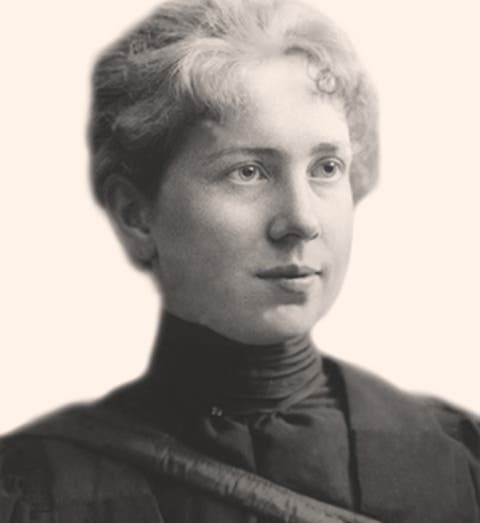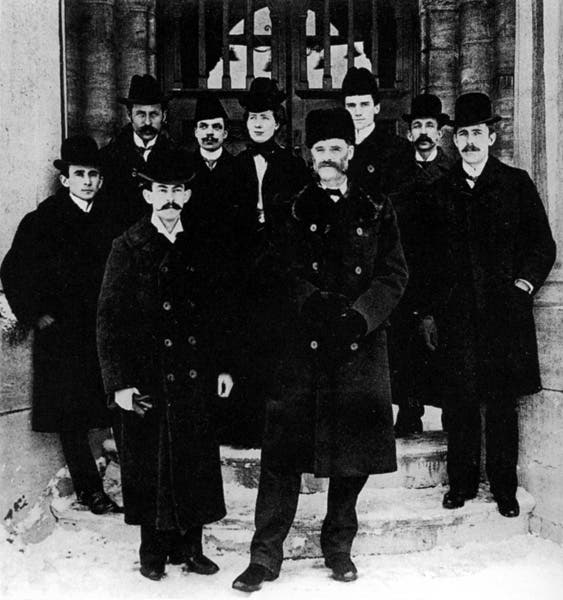Scientist of the Day - Harriet Brooks
Harriet Brooks, born July 2, 1876 in Exeter, Ontario, enjoyed the distinction of being the first graduate student to work with Ernest Rutherford, a giant (both physically and intellectually) of early atomic physics. They enjoyed a happy, productive period of collaboration until their lives diverged in dramatically different directions.
Harriet Brooks was the third of nine children born to Elizabeth Worden and George Brooks, a commercial traveler for a flour company. The family’s move to Montreal in 1894 proved fortunate for Harriet, who attended McGill University on scholarships and graduated with honors in mathematics and natural philosophy in 1898. That same summer, Rutherford arrived at McGill as a 28-year-old physics professor fired up about radioactivity.
Together, Brooks and Rutherford studied what he called “radium emanation.” Their joint paper, published in 1901 in the Transactions of the Royal Society of Canada, identified this mysterious substance as a heavier-than-air gas.
The new gas appeared to be another new radioactive element, though they dared not label it as such. At the time, no respectable scientist would boast of turning one element into another – a claim that smacked of alchemy. As the pace of discovery and understanding accelerated, however, “emanation” indeed proved to be a new addition to the periodic table: the element radon.
In pursuit of a doctoral degree (not then offered by McGill), Harriet Brooks continued her research as a Fellow in Physics at Bryn Mawr College in Pennsylvania. Again she distinguished herself, winning the Bryn Mawr President’s Fellowship for graduate study in Europe. Rutherford intervened to place her with his own mentor, J. J. Thomson at the Cavendish, where she spent the 1902-1903 academic year. Then, instead of returning to Bryn Mawr to complete her studies, she returned to McGill, to Rutherford. Here she made a startling discovery that she reported in a letter to Nature in 1904: In addition to releasing a gas, radium also ejected radioactive atoms that could accumulate on a non-radioactive surface.
This phenomenon, now known as radioactive recoil, was reported with excitement four years later by Lise Meitner and Otto Hahn. Rutherford told them right away that Harriet Brooks had seen the same thing well beforehand, and Hahn eventually credited her as the first observer when he wrote his autobiography. A photograph of 1901 shows the lab in the MacDonald Physics Building where Brooks and Rutherford worked.
Most likely following her heart, Harriet Brooks left McGill in 1905 to teach physics at Barnard College, the women’s part of Columbia University, where she was reunited with Bergen Davis, a fellow physicist she’d met at the Cavendish. In the summer of 1906, when she informed officials at the college of her engagement to Davis, they requested her resignation.
She stood up to the dean, claiming “a woman has a right to the practice of her profession and cannot be condemned to abandon it merely because she marries.” That said, she broke up with Davis and spent the following year as an independent researcher at the Curie lab in Paris.
Marie Curie had assumed directorship of the lab at the Sorbonne following her husband’s death in April 1906. She was pleased with Brooks, her first hire, and invited the talented young scientist to stay on for at least another year. Brooks chose instead to rejoin Rutherford, who had moved to the University of Manchester. Eager to welcome her again, Rutherford supported Brooks’s fellowship application with a sterling letter of recommendation, in which he insisted that “next to Mme. Curie she is the most prominent woman physicist in the department of radioactivity.”
Midway through these arrangements, marriage to an old flame from McGill took Harriet Brooks back to Montreal. As wife of physics instructor Frank Pitcher and mother of three children, she pursued no further study of radioactivity, though she helped other female researchers win scholarships through her involvement with the Canadian Federation of University Women. The Pitchers lost their son Charles to meningitis at age fourteen. They were stricken again when their eighteen-year-old daughter, Barbara, went missing between classes at McGill in March 1929 and was found weeks later, drowned.
Harriet Brooks died on April 17, 1933, after a lingering but undisclosed illness. She was 56 years old. Rutherford submitted a formal obituary notice to Nature describing her important contributions. He expressed his personal loss in a letter to a colleague:
“She was a woman of great personal charm as well as of marked intellectual interests. I am afraid her domestic life was not without serious trials which she bore with astonishing fortitude. My wife and I held her in great affection and her premature death is a grievous blow to us.”
Dava Sobel is the author of Longitude, Galileo’s Daughter, and, most recently The Glass Universe. She is writing a new book about the women who worked in Madame Curie’s lab.






![Columbine, hand-colored woodcut, [Gart der Gesundheit], printed by Peter Schoeffer, Mainz, chap. 162, 1485 (Linda Hall Library)](https://assets-us-01.kc-usercontent.com:443/9dd25524-761a-000d-d79f-86a5086d4774/3829b99e-a030-4a36-8bdd-27295454c30c/gart1.jpg?w=210&h=210&auto=format&fit=crop)
